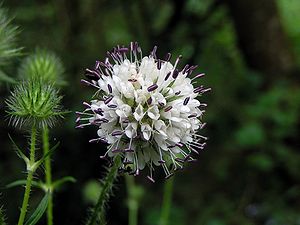Hairy teasel
| Hairy teasel | ||||||||||||
|---|---|---|---|---|---|---|---|---|---|---|---|---|

Hairy teasel ( Dipsacus pilosus ) |
||||||||||||
| Systematics | ||||||||||||
|
||||||||||||
| Scientific name | ||||||||||||
| Dipsacus pilosus | ||||||||||||
| L. |
The hairy teasel ( Dipsacus pilosus L. , Syn .: Virga pilosa (L.) Hill ) is a species of the cardiology ( Dipsacus ) in the subfamily of the cardiaceae (Dipsacoideae).
features
The hairy teasel is a biennial plant that reaches heights of 60 to 120 centimeters. It is upright and branched. Both stems and leaves are more or less hairy and prickly. The leaves are fused at the base. The lowest are long-stalked, ovate, usually with entire margins and sometimes have two smaller leaflets . The upper leaves are ovate-elliptical , short-stalked and often tripartite .
The white or yellowish-white colored flowers are arranged in a dense, spherical, cephalic inflorescence , which has a diameter of 2 to 2.5 centimeters and nods before opening. The bracts are bristly ciliate and long pointed. The bracts are a little longer than the flowers.
The flowering period extends from July to August.
The number of chromosomes is 2n = 18.

ecology
The hairy teasel is a hemicryptophyte . The pre-male flowers open one after the other in concentric zones; they are pollinated by insects (preferably bumblebees ).
Occurrence
The hairy teasel occurs in central and northern southern Europe in light forests, alluvial forests, on river banks, damp forest and path edges, fences and hedges. Its distribution area includes the countries Spain, France, Great Britain, Italy, Switzerland, Belgium, the Netherlands, Denmark, Germany, the Czech Republic, Slovakia, Poland, Austria, Liechtenstein, Slovenia, Croatia, Serbia, Hungary, Bulgaria, Romania, the Ukraine, Turkey, Molldavia, the Caucasus and European Russia.
In Germany this species is scattered to rare.
According to Ellenberg , it is a semi-light plant, intermediate continental distribution and growing in nitrogen-rich locations. It is a type of association of the leek-herb fringes (Alliarion) and often occurs in the Dipsacetum pilosi.
Taxonomy
Dipsacus pilosus L. also has the synonyms Cephalaria pilosa (L.) Gren. & Godr. and Virga pilosa (L.) Hill .
use
The hairy teasel is also cultivated as an ornamental plant.
literature
- Gunter Steinbach (Ed.), Bruno P. Kremer u. a .: wildflowers. Recognize & determine. Mosaik, Munich 2001, ISBN 3-576-11456-4 .
- Siegmund Seybold (Ed.): Schmeil-Fitschen. Interactive flora of Germany. Seeing - determining - knowing. The key to the flora . CD-ROM, version 2.0. Quelle & Meyer, Wiebelsheim 2004, ISBN 3-494-01368-3 .
- Siegfried Schlosser, Lutz Reichhoff, Peter Hanelt: Wild Plants of Central Europe. Use and protection. Deutscher Landwirtschaftsverlag, Berlin 1991, ISBN 3-331-00301-8 .
Individual evidence
- ↑ a b Erich Oberdorfer : Plant-sociological excursion flora for Germany and neighboring areas . With the collaboration of Angelika Schwabe and Theo Müller. 8th, heavily revised and expanded edition. Eugen Ulmer, Stuttgart (Hohenheim) 2001, ISBN 3-8001-3131-5 , pp. 885 .
- ↑ G. Domina (2017+): Dipsacaceae. - In: Euro + Med Plantbase - the information resource for Euro-Mediterranean plant diversity. Datasheet Dipsacaceae
- ↑ Heinz Ellenberg : Vegetation of Central Europe with the Alps in an ecological, dynamic and historical perspective (= UTB for science. Large series . Volume 8104 ). 5th, heavily changed and improved edition. Eugen Ulmer, Stuttgart (Hohenheim) 1996, ISBN 3-8252-8104-3 , pp. 1036 .
Web links
- Hairy teasel. In: FloraWeb.de.
- Hairy teasel . In: BiolFlor, the database of biological-ecological characteristics of the flora of Germany.
- Profile and distribution map for Bavaria . In: Botanical Information Hub of Bavaria .
- Dipsacus pilosus L. In: Info Flora , the national data and information center for Swiss flora . Retrieved April 1, 2016.
- Thomas Meyer: Card data sheet with identification key and photos at Flora-de: Flora von Deutschland (old name of the website: Flowers in Swabia )
- photos
- photos


